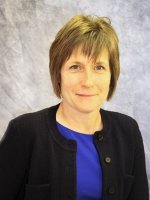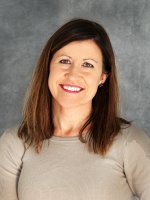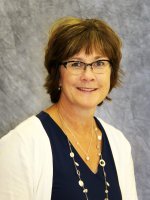Service Units Support: ESU 17 helps Northern Central Nebraska districts move forward in pandemic
Service Units Support: ESU 17 helps Northern Central Nebraska districts move forward in pandemic
By Tyler Dahlgren
Before joining a panel discussion centered around pandemic relief and held, like most everything these days, on Zoom, Geraldine Erickson, Patty Finney and Misty Wroblewski put together a bulleted list to help retrace their steps since early March.
The list, which detailed the different types of support ESU 17 provided its five districts located in the northern central region of the state when COVID-19 abruptly halted the school year, ended up being extensive. And growing.
Progress by design.
“We always kept looking forward,” said Wroblewski, a school psychologist with the service unit. “We did the best job that we knew how to do at the time during the school year, but we always had our eye down the road.”
From creating professional learning and collaboration opportunities for similar-grade teachers from Ainsworth, Cody-Kilgore, Keya Paha, Rock County and Valentine, to facilitating Zoom meetings for educators and administrators to share best distance-learning practices and re-opening ideas, ESU 17 has had more than a hand in moving education through uncertain times in a part of the state where collaboration and relationships are vital.
Relationships. That word seemed to stick at the forefront of the roundtable discussion, a common denominator through each avenue and tier of support ESU 17 provides. Though ESU 17’s geographical area is large, covering all of Keya Paha, Rock, Brown and the majority of massive Cherry County, the service unit is unique in that it serves a small number of districts.
“Districts that tend to work together very closely,” explained Erickson, ESU 17's Administrator. “Relationships get you a long ways. We’ve developed great relationships with these districts. Parents know that we’re here to do what’s best for their children.”
Erickson knows the area well, having spent 18 years at ESU 17, the last four as administrator. The willingness of ESU 17’s district superintendents to work together smoothed out the transition to a world of digital education.
“We were already doing things to help bring teachers that were singletons in their districts together to give them an extra system of support, and during the closure we just really ramped that up and facilitated opportunities for like-content area and like-grade brand groups to get together,” Erickson said. “Just to give them a chance to connect, as much as anything.”
Like Erickson, Finney, ESU 17’s Technology Integration Specialist, started her career as a teacher and then made the move to tech support at a rural K-8 school before joining the service unit in 2000. When closures were announced, each district surveyed families on internet access and device availabilities and reached out to ESU 17 right away for support.
Circumstances varied from district to district, with most elementary schools opting to send home packets to carry on with curriculum and most middle and high schools making the move to E-Learning. In north-central Nebraska, distance learning, in most cases, means DISTANCE learning.
“We do have pockets in our area that internet is just not an option, where self-service isn’t even an option,” said Finney. “But our districts did a phenomenal job of trying to meet the needs of both those that had internet, and those that did not.”
ESU 17 offered training for teachers in various forms of tech, including Zoom and Google Classroom. The teachers, who jumped at these opportunities without hesitation, then turned around and trained parents.
One of the driving questions that the leadership at ESU 17 asked itself initially was how to equitably serve students with disabilities. They were already serving the families of birth-to-three children with disabilities using a coaching model, which helped in the quest to expand services across a broader range of students.
“We knew that if we wanted to continue to make an impact on those children’s development, then we had to give the parents the tools they’d need to improve their child’s functioning,” said Erickson. “And since we were already working in that format, we weren’t presenting ourselves as the therapists who solve problems in thirty minutes once-a-week. We were able to, in almost every case, continue to meet with those parents either via Zoom or via telephone and provide services to those birth-to-three children.”
As a school psychologist, Wroblewski plays many roles in schools. When they closed their doors, there were still students who needed support, perhaps more than ever. Special education coordinators and directors started to meet weekly to devise an innovative and alternative plan that best served students while following all guidelines.
“Our providers did an excellent job finding ways to meet virtually with students and provide them with the support that they needed,” said Wroblewski, who taught second, third, fifth and sixth-grade for 11 years before earning a school psychology degree and starting at ESU 17 three years ago. “I mean, we had providers working like crazy to provide services for kids. A lot of effort was put into that area.”
One particular district was even able to maintain the exact timeframe of services that they operated with before the pandemic through the remainder of the school year.
“I have not seen providers work harder than they did during the building closures,” Erickson added. “It’s been everybody. Everybody has stepped up to the challenge.”
Enjoy this Q&A with ESU 17 Staff!
Q: You talk about how it was a collective rising to the challenge from everyone. Did you see that from parents, too? They are a big piece of the puzzle, too. How was working with them and how important were open lines of communication all the way from you to your districts to the families you both serve?
Geraldine Erickson: We really have the benefit here of having schools that work really hard to do what is best for their students. And they’ve developed great relationships with those parents. When all of this was happening and when we were scrambling to figure out what the paperwork for special education should look like and a million other things, I reassured districts that relationships get you a long ways.

(Pictured Above: Geraldine Erickson, ESU 17 Administrator)
Q: I think one of the most interesting things about the adversity was that we were all kind of in the same boat. I wanted to ask each of you, how have you personally transitioned to kind of working in a digital world? Whereas, maybe before you were out in schools and face to face with teachers and students and now, like everyone else, you're utilizing Zoom and you're offering as much support you can from a distance. So how was that transition for your team at ESU 17?
Misty Wroblewski: I can say that I am thankful for the colleagues that I have, because I feel like I relied on them a lot for any questions I had with Zoom, especially in the beginning. I’d used Zoom before, but all of the ins and outs and the extra features and the etiquette pieces, that all goes together. And all of the planning that we did to get ready for different things during that time. I just felt really fortunate to work where I do and the colleagues that I do because they pulled me through a lot of it.

(Pictured Above: Misty Wroblewski, ESU 17 School Psychologist)
Patty Finney: I’ll echo that. We’re very fortunate to have a very caring staff. Everybody tried to be there for each other, both professionally and emotionally. We tried to be that mental support for one another. I think most of our teachers know us by first name and we know them by first name. It was a huge advantage for us to have those personal relationships with teachers. I do think we all realized that Zoom meetings can really wear you out, but I think we’ve been very productive.

(Pictured Above: Patty Finney, ESU 17 Tech Integration Specialist)
Q: It will be awhile before we look around and realize everything is back to normal. If that ever happens at all. But three and a half months after all of your school districts were forced to abruptly close their doors, when you look back on that time, what are you most proud of in the way ESU 17 and its districts responded?
Misty Wroblewski: There’s a lot to be proud of. Before this meeting, we set up a bulleted list of things that we had done during this time to prepare ourselves for this discussion. When you get to looking at that list, it’s a pretty impressive amount of things that were put together rather quickly to serve our students and our teachers. Everything from grade-bands of people, educators having Zoom meetings together to talk about content and curriculum and what’s working for them, and administrator meetings to keep them all current on information and a plan for reopening.
We had done a lot of work with PBIS and most of our districts have moved into that multi-tiered systems of support model and already have worked through the first set of awareness training. This summer, we went ahead and did the re-plan and refocus of the things that continued in the virtual world.
We always kept looking forward. Our goal here is that when we return to normal circumstances, we’re not going to be far behind. We’re going to have a plan for what needs to happen to get kids to where they need to be and we’re going to help teachers feel equipped to handle whatever is needed in the fall. That hard work is one of the things we’re most proud of.
Patty Finney: Our proactive collaboration and our continued work. We had started some social studies curriculum work during the school year as a service unit, and we were scheduled to do that at the end of the year and chose not to cancel. We went ahead and did it via zoom. We had grade-level bands that continued to talk about the learning progressions for those standards and indicators. We had tremendous collaboration during all of this.
Geraldine Erickson: I really appreciated being able to participate in those teacher Zooms, too. I appreciated the level of participation we had there. It was the ESU staff working really hard, but there were school staff working really hard to.
I don’t get to talk to classroom teachers as much as I would like to, and again, because of our wide geographic area, travel sometimes becomes a limitation and takes up a lot of our time. And I know we’re all looking forward to the day when we can sit down in a room together, but you learn a lot about the value of technology during something like this. I just finished participating in the psychological first-aid training that Jolene Palmer from NDE led. She was able to do that via Zoom for our ESU 17 area. You learn a lot about the value of Zoom.
I always think when something bad happens, we should look for what good can come of it. And I really do believe good things will come of this. I hope we’re not satisfied with stepping back to where we were before this happened.


